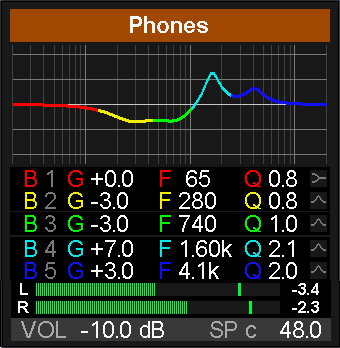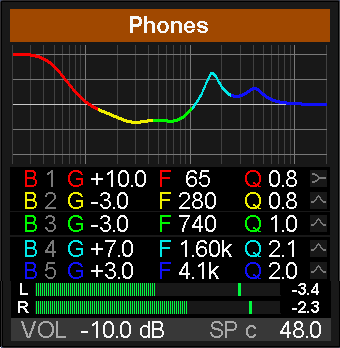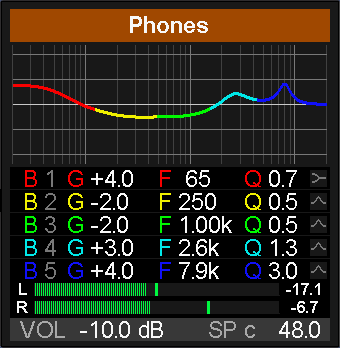Topic: Additions on the Extreme Power headphone video
This is not the forum to discuss the sound of headphones. But having built two very successful devices with superb headphone outputs, the ADI-2 Pro and ADI-2 DAC, they have become an ongoing topic, with sometimes the same question repeated over and over again (does my headphone XXX work with…).
We shot a very basic, simplified video about the Extreme Power output stages of Pro and DAC and how they work with some typical headphones. It is published in our YouTube channel:
https://www.youtube.com/watch?v=15Zyuo- … e=emb_logo
Requests for more information, guidelines and ideas were easy to predict, so I thought I share a more detailed overview on the headphones currently lying around in my lab.
This is by no means a full and objective review of them, nor a recommendation in any way. I have a really hard time to recommend headphones, as I am fully aware of the many different, fully subjective and personal preferences. This broad range of different tastes and likings is the simple reason that there exist so many headphones which all find their lovers.
So don’t take my descriptions and findings as gospel. They might help you – or not.
But first things first: as mentioned in The Manual, the Extreme Power output drives all headphones very well. Exceptions are models that are either outdated or rare, mostly the super-power hungry AKG K1000 and HIFIMAN HE6. Both require a real power amp (for speakers) to drive them to acceptable volume levels.
The photo below shows some of my more often used headphones. Some more are tucked away, and four more are mounted at my workstations for immediate use.

From left to right, alternating front/back, IEMs at the end:
Audio Technica ATH-M50X: closed, low impedance, high sensitivity dynamic headphone with a lot of oomph and higher mid/presence, which makes it sound open and special. Most distracting for me are the too small earpads (I have big ears). One can easily exchange them with bigger ones (Shure fit well), but this also changes the sound a lot to the worse. This phone is a studio standard, so kept as reference.
JVC HA-SZ2000: closed, low impedance, high sensitivity dynamic headphone, no longer available. The king of bass with a unique dual driver design per side. Sounds like shit without EQ. With EQ its thunderous and physically head-shaking bass down to 16 Hz is something one has to experience at least once. As these phones can easily eat 1.5 Watts at only 14 Ohms, and didn’t cost a fortune (now they do) they are also very good lab power test dummies. That’s why I have several of them, the Japanese and Europe versions from both HA2000 and HA1000.
Mr. Speakers Aeon Closed (now Dan Clark Audio): low impedance, low sensitivity planar headphone. I got one of the first Aeon. For a planar it is astonishingly light weight, has soft and big earpads and is therefore very comfortable to wear. Good, unique overall sound. Kept as reference. If I lived in the US I would have updated already to the Aeon 2, which promises a bit more bass, and has an ingenious, foldable headband, making it fully portable.
beyerdynamic DT-990 Pro: open, high impedance, low sensitivity dynamic headphone. Yes you see that right – a spiral headphone cable! This phone has been my favourite for many years, back to the times when the number of available headphones was small and their sound mostly horrible. The 990 is lightweight, has very comfortable earpads, and a v-style tuning (more bass and a bit peaky treble). Unfortunately this was the phone which made me aware of intermodulation distortion when trying to play music with very low bass content. Kept as reference.
Audeze LCD-X: open, low impedance, medium sensitivity planar headphone with a very special, clear sound. Super low distortion no matter the volume and bass. Soft and big earpads to compensate the high weight (planar design with double-side magnets cannot be lightweight). I really like its sound (with Treble shelf raised by 3 dB), no matter what measurements say about the erroneous treble region. Cabling is provided balanced and unbalanced, and as they can eat several watts they would be perfect power load test dummies too. But I keep that task for the much cheaper JVCs. Clearly a reference to keep.
JVC HA-SZ1000: see above, basically identical to the SZ-2000. Note that all five models that I have sound a bit different. I dare to say this is not because of real differences in design, but no matching and bad quality control during manufacturing.
HEDD HEDDphone: open, medium impedance, low sensitivity AMT (air motion transformer) headphone. This latest introduction to the ever expanding headphone market brings some real innovation instead of the usual marketing bla – an AMT full range driver as headphone speaker. This is the most heavy headphone I ever had. Very soft and comfortable, big earpads shift parts of the weight from the top to the sides. One has to applaud HEDD for trying to bring this technology to the market, and I bet in a few years we will see more lightweight versions of it. And yes, it sounds different (again, like any headphone) but in a very positive way, so worth to try.
Bluedio R+: Bluetooth multi-driver headphone. Uh oh – kept as bottom reference (insert facepalm here).
Fostex – Massdrop TR-X00 PH: low impedance, high sensitivity dynamic headphone. Lots of deep bass and max volume with little distortion, maybe a bit too much treble. Not enough inner earpad space. Absolutely horrible, stiff, tangling and noisy cable that is not easy to replace due to limited availability of the special Fostex connectors at the cups. Embarrassing how (Mass-) Drop brags about improving all ‘their’ versions in details and then can’t see or fix this annoyance. Kept to give the phones collection more colour.
A bit covered in the back: Audeze Mobius. This Bluetooth planar with tons of exciting additional features and even gaming support (including mic) was a definitive must-have when it appeared. Unfortunately the sound was rather disappointing in the beginning, as the included DSP-EQ did not provide any sound change through its multiple choices. Plus the most important/critical feature, the mic, failed. While all this is fixed nowadays my son still prefers his more lightweight, standard dynamic headset for battling through the hours. Kept as Bluetooth reference.
Sennheiser HD650 / Massdrop HD 6XX: open, high impedance, low sensitivity dynamic headphone. Lightweight, but a bit too stiff ear pads. Still comfortable. Praised for its linear, uncoloured sound, although quite bass-shy. Kept as reference. Tip: balanced cables can be done very cheap by ordering a standard replacement cable and replacing the TRS with whatever you need, as both sides run separately down to that connector.
Bose (Quiet Comfort) QC 15: closed Bluetooth headphone that can also work wired and was a reference for noise isolation. These days there are not only newer models but also tough competition. In fact the Sony WH-1000XM3 is much more popular in my family and therefore not seen in the photo. Kept as reserve.
Cut off from the pic, left down, not visible: beyerdynamic DTX-350. Closed, low impedance, high sensitivity dynamic on-ear headphone. My travel phone for many years. Sounds several classes better than its price predicts. Highs can be a bit problematic (the beyer peak), but nothing a simple EQ can’t fix (I use Neutron on my iPhone and iPad).
Front IEM in custom case: InEar ProPhile 8. Low impedance, medium sensitivity in-ears with 8 (!) drivers per side, crossover-separated into 4 bands. The best sounding, un-coloured and amazing headphone / earphone I ever heard (don’t forget, this is fully subjective and might not apply to your taste/opinion at all). Except for the very deep bass, where IEMs generally struggle due to not being able to physically transfer vibrations to the skull as some headphones can do. They replaced my DTX-350 as travel phones, and I couldn’t be happier.
Front second IEM: cheap Massdrop x NuForce EDC in-ear monitors. Well, you get what you pay for. Kept as low cost reference.
Not on this photo: Sennheiser IE400 Pro. Cheaper alternative to the ProPhile 8. With just one dynamic driver per side Sennheiser managed to provide an astonishing sound quality. Biggest drawback for me is that they don’t provide big enough ear tips to close the big holes of my ear canals. A personal annoyance that these share with many other manufacturers. Why nobody makes XXL tips?
Not on this photo (at my office desk): Sony MDR-Z7M2. Closed, medium impedance, medium sensitivity dynamic headphone with unusual big drivers (70 mm !). As I wrote in the beginning this topic is highly subjective and personal, but people will ask anyway, so I try to explain why this is currently my most often used headphone. It simply ticks most of my boxes. Design, craftsmanship, manufacturing, details, material, looks – all absolutely amazing. Comfort level 120% with medium weight and big, soft earpads. Screwed cable connection with the right angle, and a very soft, not tangling and noiseless cable (eat this, Drop!). Nice sound with very deep bass extension. Highs are a bit too recessed for my geriatric ears, so I dialed in a simple PEQ correction filling up two bands (see below) where measurements show a drop. Perfect. For me. YMMV, of course…
Also not on this photo: tons of other headphones that I tried over the years and especially in the time the ADI-2 Pro was developed. I had no reason to keep them when they did not meet my personal taste, but had passed the Extreme Power output test, and would then just lie around as dead money.
A quick note on headphone stands: the ones in the photo are mostly very cheap no-name ones from Amazon https://www.amazon.de/Kopfh%C3%B6rerst% … B07PHWNHP2 which do not leave marks on the headband, are high enough and still stable.
The heavier phones are parked on the king of stands – German engineering, of course – Rooms Audio Line FS Pro A BK Headphone Stand. Made of solid steel they stand like glued to the table. Height is adjustable, and even damped while adjusting. Available with two different radius to perfectly match the phone’s headband. Also available in silver and wood versions.
At my desk and workstations I use a simple clamp with curved surface, also not leaving marks on the headphone: https://www.k-m.de/en/products/accessor … lder-black
Measurements and setting up the PEQ
There is no final truth. Neither the diffuse field nor Harman curve is guaranteed to bring you the highest joy in listening. But measurements of headphones DO highlight the flaws in them. How much correction is needed and which flaws to tackle then is your personal decision. So you get some guidance, but you have to fine-tune yourself. For example the Sony’s MDR-Z7M2 recommended EQ boosts the mid area around 1.2 kHz by 2.5 dB. I don’t like that. To me it sounds better without that correction. But I agree in fixing the drop at 4.3 kHz and above 8 kHz. My simplified PEQ does this:

B4 G +6.5 dB F 4.3k Q 4.8 (Peak)
B5 G +5.0 dB F 10.0 kHz Q 1.3 (Shelf)
That already gives the Sony a much nicer and fully reconstructed treble sound. Now with
B1 G X.X dB F 65 Hz Q 0.8
I can dial in as much deep oomph as I want, without the bass getting bloated or leaking into the lower mids. Fun all around!
You can follow the recommended EQ corrections more closely, as the ADI PEQ has 5 bands, and even Treble and Bass can be included (as Oratory1990 successfully shows). But in my experience many of the smaller corrections do not give any audible change, or (see above) might even change the sound to something you don’t like. Just experiment with it. Doing so be warned, your ears quickly adapt to any change! You might end up in settings that scare the hell out of you when you put the phones on again one day later. What you need is a second source (headphone) as reference to compare the dialed-in EQ.
I know it is easy to get lost here, and understand why people look for the 'perfect' EQ setting so they don’t have to do all this. Still in my opinion there is no such ‘perfect’ one that suits all tastes and ears. So if you really wish Nirvana you will need to invest some time.
Sources
AutoEQ: https://github.com/jaakkopasanen/AutoEq … er/results
Oratory1990: https://www.reddit.com/r/oratory1990/wi … of_presets
I hope this little overview and experience report provides some insight and helps you to find the ideal headphone that matches your ears!
Matthias Carstens
RME


